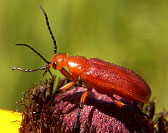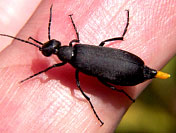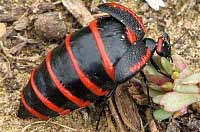 |
Family Meloidae – Blister Beetles Blister beetles produce cantharidin, a poisonous substance comparable to cyanide and strychnine in toxicity. Beetles Index |
Custom Search
|
Lytta aenea feeding on Blackthorn Sloe, Prunus spinosa |
|
Blister beetles produce cantharidin, a poisonous substance comparable to cyanide and strychnine in toxicity. Stored in the insects' blood, the compound is stable and remains toxic even in beetle carcasses. Animals may be poisoned by ingesting beetles while grazing or eating harvested silage. Cantharidin can also cause severe skin inflammation and blisters.
Cantharidin is absorbed through the intestine and can cause symptoms such as inflammation, colic, straining, elevated temperature, depression, increased heart rate and respiration, dehydration, sweating, and diarrhea. There is frequent urination during the first 24 hours after ingestion, accompanied by inflammation of the urinary tract. This irritation may also result in secondary infection and bleeding. Taken internally, as little as 10 milligrams can be fatal in humans. The concentration of cantharidin in adult beetles depends primarily on the sex; males produce the chemical and only pass on small amounts to the females during mating. Cantharidin amounts also depend on species; the striped blister beetle has approximately five times more catharidin than the black variety. In one species, Méloé proscarabaeus, cantharidin makes up fully 1/4 of the insect’s blood. There are other insects, including some beetles, flies, bugs that eat live or dead blister beetles to obtain the protective qualities of this chemical defense; these so-called cantharidinophilous insects have acquired immunity from the chemical and remain unharmed. [2] Male fire-colored beetles in the family Pyrochroidae are known to climb onto blister beetles and ingest the cantharidin exuded by the insect. Completely immune to the effects of the blistering agent, they use the chemical to attract females, who become the recipients of a cantharidin-laden sperm packet with which they coat their eggs. |
Beetles Main | Beetles Index | Longhorns | Leaf Beetles | Soldier | Blister | Lady | Scarab
 Orange Blister Beetle |
 Black Blister Beetle |
 Water-Carrier Blister Beetle |
|
Blister Beetle adults feed on leaves in the tops of a plant but are especially attracted to flowers where they feed on nectar and pollen. These early spring beetles are feeding on a blackthorn sloe, a relative of the common cherry tree.
Female blister beetles lay clusters of eggs in the soil in late summer. The small, active larvae that hatch from these eggs crawl over the soil surface entering cracks in search for grasshopper egg pods. On finding a grasshopper egg mass, the larvae become immobile and spend the rest of their larval time as legless grubs. The next summer they pupate soon emerge as adults. Blister beetle populations follow closely the abundance of grasshoppers the year previous. |
|
References
|
| Tree Encyclopedia / North American Insects & Spiders is dedicated to providing scientific and educational resources for our users through use of large images and macro photographs of flora and fauna. |
Order Coleoptera: Beetles are the dominant form of life on earth: one of every five living species is a beetle. Coleoptera is the largest order in the animal kingdom, containing a third of all insect species. There are about 400,000 known species worldwide, ~30,000 of which live in North America. Beetles live in nearly every habitat, and for every kind of food, there's probably a beetle species that eats it. |
